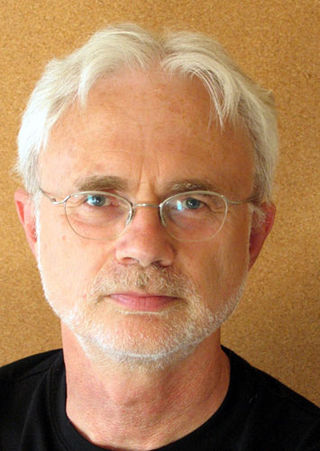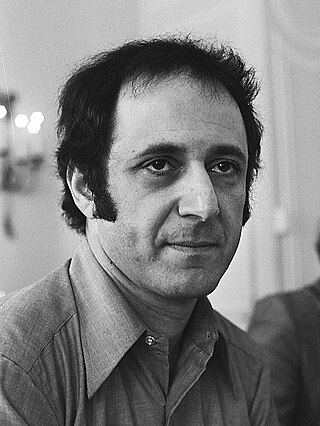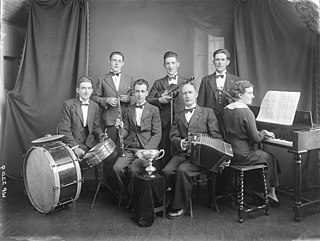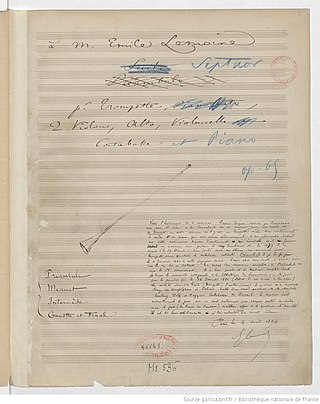
John Coolidge Adams is an American composer and conductor whose music is rooted in minimalism. Among the most regularly performed composers of contemporary classical music, he is particularly noted for his operas, which are often centered around recent historical events. Apart from opera, his oeuvre includes orchestral, concertante, vocal, choral, chamber, electroacoustic and piano music.

Stephen Michael Reich is an American composer who is known for his contribution to the development of minimal music in the mid to late 1960s. Reich's work is marked by its use of repetitive figures, slow harmonic rhythm, and canons. Reich describes this concept in his essay, "Music as a Gradual Process", by stating, "I am interested in perceptible processes. I want to be able to hear the process happening throughout the sounding music." For example, his early works experiment with phase shifting, in which one or more repeated phrases plays slower or faster than the others, causing it to go "out of phase." This creates new musical patterns in a perceptible flow.

Music for Strings, Percussion and Celesta, Sz. 106, BB 114 is one of the best-known compositions by the Hungarian composer Béla Bartók. Commissioned by Paul Sacher to celebrate the tenth anniversary of the chamber orchestra Basler Kammerorchester, the score is dated September 7, 1936.

A septet is a formation containing exactly seven members. It is commonly associated with musical groups but can be applied to any situation where seven similar or related objects are considered a single unit, such as a seven-line stanza of poetry.
Danse macabre, Op. 40, is a symphonic poem for orchestra, written in 1874 by the French composer Camille Saint-Saëns. It premiered 24 January 1875. It is in the key of G minor. It started out in 1872 as an art song for voice and piano with a French text by the poet Henri Cazalis, based on the play Danza macàbra by Camillo Antona-Traversi. In 1874, the composer expanded and reworked the piece into a symphonic poem, replacing the vocal line with a solo violin part.

Sir Edward Elgar's Symphony No. 1 in A♭ major, Op. 55 is one of his two completed symphonies. The first performance was given by the Hallé Orchestra conducted by Hans Richter in Manchester, England, on 3 December 1908. It was widely known that Elgar had been planning a symphony for more than ten years, and the announcement that he had finally completed it aroused enormous interest. The critical reception was enthusiastic, and the public response unprecedented. The symphony achieved what The Musical Times described as "immediate and phenomenal success", with a hundred performances in Britain, continental Europe and America within just over a year of its première.

The Symphony No. 2 in E minor, Op. 27, is a four-movement composition for orchestra written from October 1906 to April 1907 by the Russian composer Sergei Rachmaninoff. The premiere was performed at the Mariinsky Theatre in Saint Petersburg on 26 January 1908, with the composer conducting. Its duration is approximately 60 minutes when performed uncut; cut performances can be as short as 35 minutes. The score is dedicated to Sergei Taneyev, a Russian composer, teacher, theorist, author, and pupil of Pyotr Ilyich Tchaikovsky. The piece remains one of the composer's most popular and best known compositions.
A London Symphony is the second symphony that Ralph Vaughan Williams composed. The work is sometimes referred to as Symphony No. 2, though the composer did not designate that name for the work. First performed in 1914, the original score of this four-movement symphony was lost and subsequently reconstructed. Vaughan Williams continued revisions of the work into its final definitive form, which was published in 1936.
Ralph Vaughan Williams composed his Symphony in E minor, published as Symphony No. 6, in 1944–47, during and immediately after World War II and revised in 1950. Dedicated to Michael Mullinar, it was first performed, in its original version, by Sir Adrian Boult and the BBC Symphony Orchestra on 21 April 1948. Within a year it had received some 100 performances, including the U.S. premiere by the Boston Symphony Orchestra under Serge Koussevitzky on 7 August 1948. Leopold Stokowski gave the first New York performances the following January with the New York Philharmonic and immediately recorded it, declaring that "this is music that will take its place with the greatest creations of the masters." However, Vaughan Williams, very nervous about this symphony, threatened several times to tear up the draft. At the same time, his programme note for the first performance took a defiantly flippant tone.
Electric Counterpoint is a minimalist composition by the American composer Steve Reich. The piece consists of three movements, "Fast," "Slow", and "Fast". Reich has offered two versions of the piece: one for electric guitar and tape, the other for an ensemble of guitars. The work shares similarities with Reich's New York Counterpoint.
The Septet in E-flat major for clarinet, horn, bassoon, violin, viola, cello, and double bass, Op. 20, by Ludwig van Beethoven, was sketched out in 1799, completed, and first performed in 1800 and published in 1802. The score contains the notation: "Der Kaiserin Maria Theresia gewidmet". It was one of Beethoven’s most popular works during his lifetime, much to the composer's dismay. Several years later, Beethoven even wished the score to have been destroyed, saying: "That damn work! I wish it were burned!"

Serenada Schizophrana is a suite of six symphonic movements written by American film composer Danny Elfman in 2004. It was commissioned by the American Composers Orchestra, which premiered the work at Carnegie Hall in New York City on February 23, 2005, conducted by Stephen Sloane. A studio recording was released on October 3, 2006, with John Mauceri conducting the Hollywood Studio Symphony orchestra. Album art was done by George Condo.
The Symphony No. 1 in B♭ minor is one of two symphonies by the English composer William Walton. The composer had difficulty in completing the work, and its first public performance was given without the finale, in 1934. The complete four-movement work was premiered the following year.
Lawrence Ball is an English musician and composer who lives in North London. He produces multi-media compositions, performs in concert, and also works as a private tutor in mathematics, music theory and physics.
Grand Pianola Music is a minimalist composition by the American composer John Adams written in 1981. It was premiered on February 26, 1982, by the San Francisco Symphony in the Japan Center in San Francisco as part of a series called "New and Unusual Music". The pianists Robin Sutherland and Julie Steinberg, sopranos Marlene Rozofsky and Eileen Williams, and alto Elizabeth Anker performed with the orchestra. The composer conducted.
Variations for Winds, Strings and Keyboards is an orchestral piece composed in 1979 by Steve Reich. The piece is scored for oboes, flutes, full brass, strings, pianos, and electric organs. Variations was Reich's first orchestral piece.
Naive and Sentimental Music is a symphonic work by American composer John Adams. The title of the work alludes to an essay by Friedrich Schiller, On Naïve and Sentimental Poetry, that contrasts a creative personality that creates art for its own sake versus one conscious of other purposes, such as art’s place in history. The composer cites both the slowly developing harmonies of Bruckner's Fourth Symphony and the atmosphere of the Sonoma coastline as inspirations for the work. The piece was co-commissioned by the Los Angeles Philharmonic, the Ensemble Modern, the Vancouver Symphony Orchestra, and the Sydney Symphony Orchestra. It received its first public performance by the Los Angeles Philharmonic conducted by Esa-Pekka Salonen on February 19, 1999. A recording by Salonen and the Los Angeles Philharmonic was subsequently released by Nonesuch Records.
Andy Akiho is an American musician and composer of contemporary classical music. A virtuoso percussionist based in New York City, his primary performance instrument is steel pans. He took interest in becoming a percussionist when his older sister introduced him to a drum set at the age of 9. Akiho first tried his hand at the steel pan when he became an undergraduate at the University of South Carolina. He began taking several trips to Trinidad after college to learn and play music. From there, he started writing pieces of his own.

The Septet in E♭ major, Op. 65, was written by Camille Saint-Saëns between 1879 and 1880 for the unusual combination of trumpet, two violins, viola, cello, double bass and piano. Like the suites Opp. 16, 49, 90, the septet is a neoclassical work that revives 17th-century French dance forms, reflecting Saint-Saëns's interest in the largely forgotten French musical traditions of the 17th century. The work was dedicated to Émile Lemoine, a mathematician and founder of the chamber music society La Trompette, who had long requested Saint-Saëns to compose a piece featuring the trumpet.
Livre pour cordes is a 1968 composition for string orchestra by Pierre Boulez. It is a revised and expanded version of the first two movements of the composer's Livre pour quatuor.







